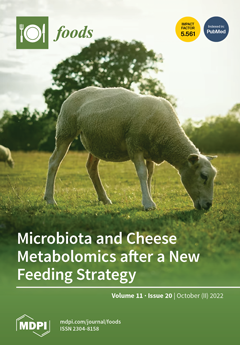An effect of a processing method (dry and wet) and a degree of roasting (light, medium, and dark) of 15 coffee (
Coffea arabica) samples on the content of caffeine, chlorogenic acid (CQA), total polyphenols (TPP), acrylamide (AA), and on the colour
[...] Read more.
An effect of a processing method (dry and wet) and a degree of roasting (light, medium, and dark) of 15 coffee (
Coffea arabica) samples on the content of caffeine, chlorogenic acid (CQA), total polyphenols (TPP), acrylamide (AA), and on the colour parameters L*, a*, and b* was evaluated. Neither processing nor roasting affected caffeine content (
p > 0.05). The degree of roasting accounted for 46% and 72% of explained variability of the CQA content and AA content, respectively (
p < 0.05). AA content was in the range from 250 (wet-processed, light-roasted samples) to 305 µg·kg
−1 (wet-processed, dark-roasted coffees), but the dark roasting only tended (
p > 0.05) to increase AA content. Wet-processed, dry-roasted coffee had higher (
p < 0.05) TPP content (48.5 mg·g
−1) than its dry-processed, dry-roasted counterpart (42.5 mg·g
−1); the method of processing accounted for 70% of explained variability of TPP. Both the method of processing and the degree of roasting affected the L*, a*, and b* values (
p < 0.01), but the lower values (
p < 0.05) of these parameters in the dark-roasted samples were found only within the wet processing. A negative correlation between the AA content and lightness (L*) was established (r = −0.39,
p < 0.05). It was concluded that from the consumers’ viewpoint, the results of the present study indicate relatively small differences in quality parameters of coffee irrespective of the method of processing or degree of roasting.
Full article






